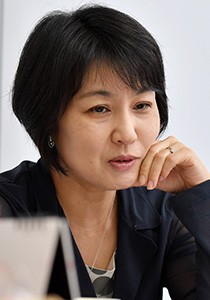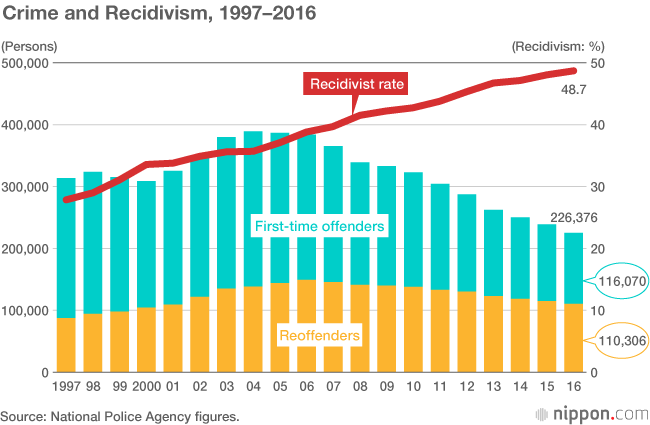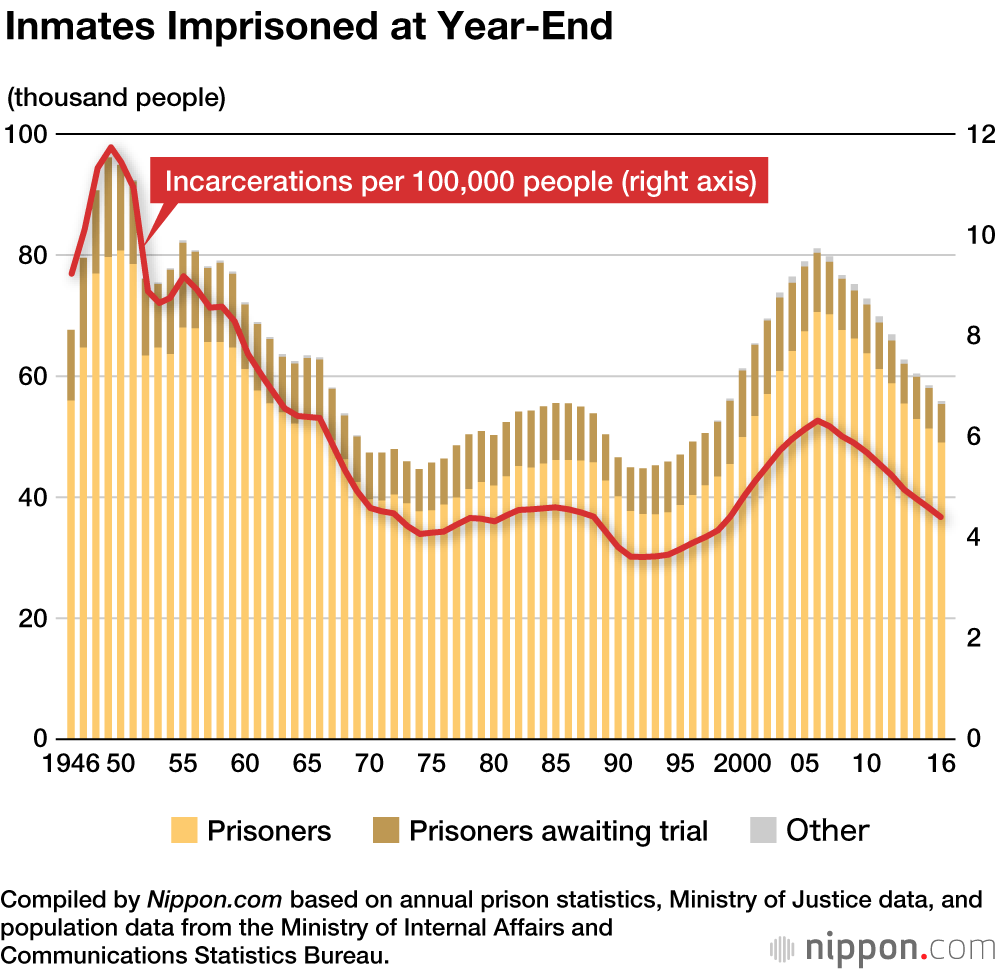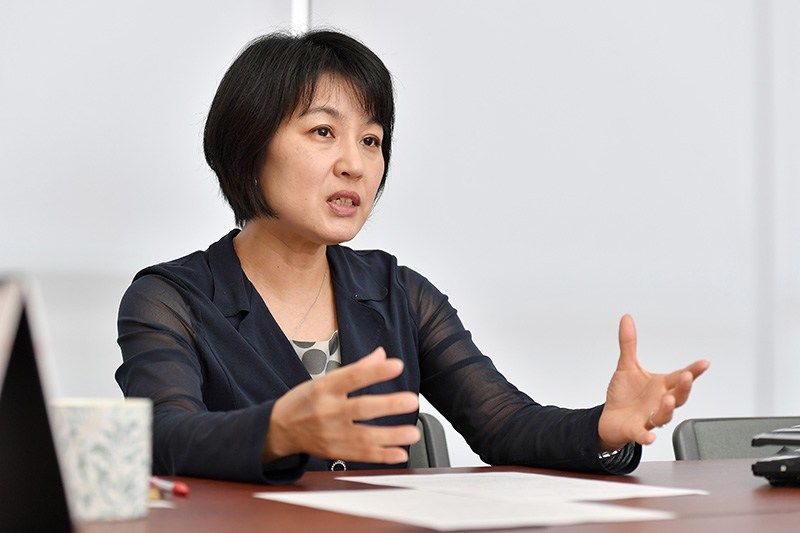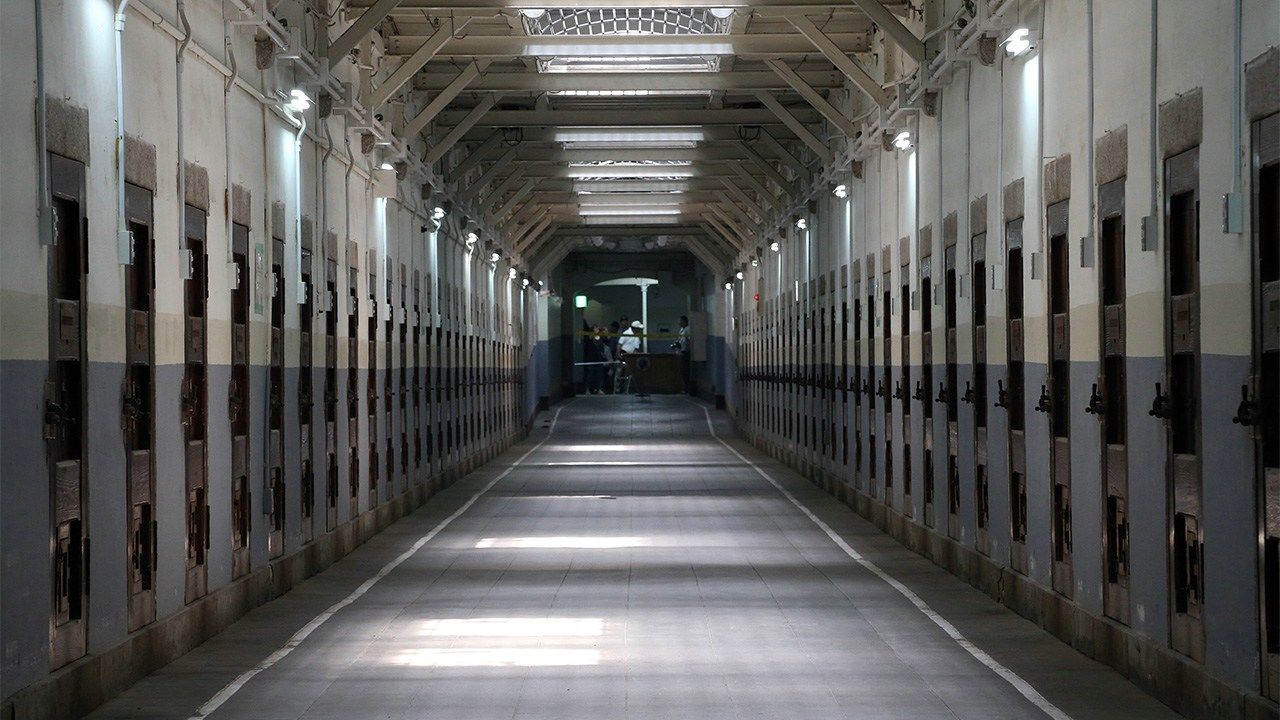
Harsh Judgment: Japan’s Criminal Justice System
Behind Bars in Japan: Fighting to Improve Prison Conditions and Inmate Treatment
Society- English
- 日本語
- 简体字
- 繁體字
- Français
- Español
- العربية
- Русский
Law and Reality
INTERVIEWER How did you become involved in protecting prisoner rights and improving conditions at correctional institutions?
TAGUSARI MAIKO In university, I was a member of a school group that studied current social issues. At the time, the Diet was debating reforms to Japan’s law governing detention facilities and the treatment of inmates. While researching the issue, I came across a book that described life in a Japanese prison. The work was full of eye-opening accounts of abuse, such as inmates having their hands bound with leather restraining devices so that they had to eat their meals from plates like dogs. It motivated me to work to improve conditions at correctional facilities and eventually led me to help found the Center for Prisoners’ Rights in 1995.
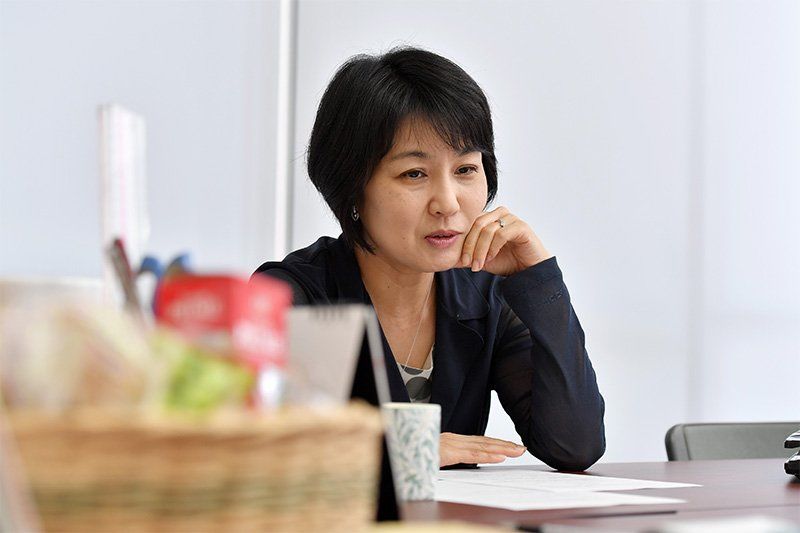
Attorney and prisoner rights activist Tagusari Maiko.
INTERVIEWER What is the historical background of Japan’s prison system, and what changed with the 2006 reforms to the law?
TAGUSARI For nearly a century, Japan’s Prison Law provided the basic rules and regulations for penal institutions. The Meiji-era legislation remained in place, unchanged, until 2006, when legislators finally revised the act to more clearly define the rights and duties of inmates.
When the new act was passed, many corrections officers objected to the changes, arguing that the numerous provisions protecting the rights of inmates made their jobs more difficult. But the general sentiment among experts was that the reforms were sorely needed to address abuses and informal procedures at penal facilities, where practices and policies had developed that didn’t always line up with the letter of the law.
The reforms, much to the delight of inmates, dramatically improved access to visitations, letters, and care packages that were strictly regulated under the old law. However, prison officials quickly moved to curb these new liberties once it became apparent that inmates affiliated with organized crime groups were abusing the system. The amended prison law stipulates that contact with the outside world is instrumental to a prisoner’s rehabilitation and smooth return to society, and unlike before, the restrictions met with a degree of resistance. Some prisoners sued on the grounds that prison officials had exceeded their authority, winning rulings from typically conservative benches.
Everything Depends on the Warden
INTERVIEWER Have conditions inside prisons improved since the reforms?
TAGUSARI There’s a degree of variability in policies and approaches among the different prisons, but overall, yes. One thing the reforms did was give wardens greater discretion in the management of facilities. As an example, wardens at facilities run under private finance initiatives are making strides in adopting progressive social rehabilitation programs. These include vocational courses, such as for becoming guide-dog trainers, and programs aimed at reducing recidivism developed together with experts from the private sector.
You have to be careful not to generalize about the impact of the reforms over entire correctional system by just by looking at one or two facilities, though. Each prison develops its own approach, and the situation can change completely, for better or worse, if a new warden is appointed. Add the fact that prison officials are typically reluctant to provide information on their facilities, and it can be quite difficult to get an overall picture.
INTERVIEWER To what degree do the rules differ at prisons?
TAGUSARI Under the old prison law, inmates were at the mercy of their incarcerators. The reforms have succeeded in curtailing harsh practices and broadened the liberties of prisoners. However, prison officials feel the measures have swung too far in the other direction and would much prefer to retain the authority to manage detainees as they see fit. In their view, tough restrictions are necessary to keep prisoners in line.
Each facility has specific security requirements based on the disposition of the inmates it houses, but the overall trend is toward tighter regulations. This is in part because you have a relatively small number of correctional officers looking after a much larger inmate population. To prevent any unexpected incidents or accidents, officials enforce a long list of specific rules and keep a close eye on prisoners to make sure the rules are being observed. This includes staff sitting in on visitations to take notes and examining inmate mail, practices that raise serious privacy questions.
By comparison, correctional institutions in other developed countries tend to take more flexible approaches in regulating inmate contact with the outside. Visitations are generally in open, communal spaces with tables and chairs, but there may also be individual rooms for inmates requiring more secure surroundings.
Behind Bars with Special Needs
INTERVIEWER What other human rights issues do you encounter in Japanese prisons?
TAGUSARI Correctional facilities house many inmates with special needs, including prisoners with cognitive disabilities or who suffer mental health problems, as well as a growing number of foreigners. However, prisons are poorly equipped to look after these detainees. First of all, most facilities are understaffed to the point that guards are unable to consider inmates’ individual requirements. There is also the matter that providing special treatment is likely to build ill will among other inmates, producing a security risk. It’s far easier to give everyone in lockup the same treatment. However, this puts people who struggle to follow broadly applied regulations at a disadvantage, and they often wind up being punished for breaking the rules.
As a party to the UN Convention on the Rights of People with Disabilities, Japan is required to promote and protect the human rights of disabled people. But the situation inside prisons is obviously not up to international standards. Guards will often refrain from punishing a misbehaving inmate who is obviously mentally ill, but such compassionate acts beg the question of why a judge found such an emotionally troubled person fit to stand trial in the first place. Correctional facilities can’t pick and choose the type of inmates they accept, though, and prison officers struggle to find the best way to respond to individual circumstances.
Fears of Backsliding
INTERVIEWER What is behind the claims that Japan has a high recidivism rate?
TAGUSARI There’s a perception that prison is a revolving door, with convicts ending up right back behind bars soon after release. The figures paint a different picture, though. The number of people imprisoned in Japan has steadily fallen for more than a decade. The rate of decline among first-time offenders has outpaced that for reoffenders, though, pushing the ratio of repeat offenders in the prison population higher and making it seem like recidivism is on the rise.
Although statistics show that Japanese society is becoming safer, the Ministry of Justice has used the recidivism rate to stoke fears among the public and legislators in a bid to cut itself a larger slice of the budgetary pie. The major news outlets have mostly gone along with the ruse by running one sensational story after another, making it seem like there is a public safety crisis. In reality, though, the exact opposite is the case.
This is not to say that the government hasn’t tried to reduce recidivism. Back in 2012, it announced plans to lower the number of prisoners who return to jail within two years of release by twenty percent over the coming decade. While the rate did fall, to achieve quick results authorities focused primarily on prisoners with short criminal histories who had the best chance of being rehabilitated.
Concentrating on low-risk inmates neglect the prisoners who are most in need of programs to help keep them from backsliding. The fact of the matter is that prisons abound with inmates who suffer emotional, cognitive, or physical problems that make it hard for them to readjust to life on the outside. This includes mental illness, the growing hordes of elderly prisoners, and detainees who lack adequate communication or problem-solving skills or who after years in jail have become institutionalized. These inmates are most in need of programs to teach them to navigate society and avoid the hazards and pitfalls that landed them in jail in the first place.
This is not to say that rehabilitation programs are ineffectual or nonexistent. It’s just that prison budgets are stretched and officials prefer to make the most of the funds, which means focusing on the prisoners least likely to reoffend. This is not likely to change unless the Justice Ministry takes the initiative to support programs focused on the highest‑risk and highest‑need inmates.
Improving Medical Treatment Behind Bars
INTERVIEWER Many experts have pointed to the sad state of medical care as the biggest issue prisons face. Have recent reforms improved the situation?
TAGUSARI A large portion of the 1,000 or so grievances we receive at the Center for Prisoners’ Rights each year concern medical care. Going from these, it would be fair to characterize Japan’s prison healthcare system as lagging woefully behind international standards for the humane treatment of inmates. Although the Justice Ministry is aware there are major shortcomings, it has struggled to come up with measures that significantly improve the situation.
In particular, there’s a dire shortage of medical doctors on staff at correctional institutions. The Justice Ministry, despite its best efforts, has failed to make much progress in wooing physicians, and most posts remain unfilled. The prison reform bill tries to ameliorate the issue to a degree with provisions like one allowing inmates to request an outside doctor for their care. The measure is hardly ever used, though. It is hard to understand why patients in civil society should be able to request an in-home doctor visit, but a person behind bars can’t.
The incredibly strict, almost excessive, security at Japanese prisons is a huge part of the problem. Officials try to limit the number of nonstaff individuals coming into the prison to an absolute bare minimum and are also extremely reluctant to allow a prisoner to visit a physician on the outside because of the risks involved. While they prefer that inmates visit the staff doctor, even this is an added burden to already stretched staff as correctional officers must escort prisoners. This has made prison authorities increasingly reluctant to grant inmate medical requests.
Emergency Measures Needed
Most correctional facilities have a nurse’s aide on staff who determines whether an inmate’s condition merits seeing a doctor. Although the prison law stipulates that inmates are to receive prompt medical treatment, officials often deny requests to consult a medical doctor on arbitrary grounds. Prisoners are able to report such abuses of authority, but frequently stay quiet or conceal medical conditions to avoid causing a stir that might affect their prospects for an early release. Prison officials like to point to the lack of grievances filed as proof that inmates are being treated humanely, but this is not necessarily the case. There are plenty of examples of sick or injured prisoners who took a sudden turn for the worse after they were denied the chance to consult a doctor by a nurse’s aide or because of understaffing.
Prison officials must of course balance security with the medical needs of inmates. However, when the two come in direct conflict, all too frequently it is the health of prisoners that takes a backseat. What the government really needs to do is transfer oversight of prison medical care from the Justice Ministry to the more appropriate Ministry of Health, Labor, and Welfare. There are steps that should be taken to improve the situation in the interim, though, like setting up pilot programs at prisons to outsource medical care to private physicians.
Rethinking Prisons
INTERVIEWER How do you think prisons should change going forward?
TAGUSARI Japan views incarceration as a last resort for people who break the law. But there are still far too many individuals behind bars, particularly repeat offenders. Many legal experts argue that stricter penalties are needed for recidivists, but this type of no-tolerance approach ensnares everyone in the same net, assuring that even perpetrators of low-level offenses are thrown behind bars. Japan has no need to enforce such strict interpretation of criminal law and must strive for a more balanced approach.
Japan could look overseas for ideas. The trend in incarceration internationally is toward small-scale prisons that are easier to staff and are better able to care for the needs of inmates. By comparison, Japan is heavily invested in large facilities housing diverse inmate populations. The government will need time to gradually downsize prisons, but in the meantime, given proper staffing and budget levels, authorities could make a range of improvements, such as by reorganizing prison populations into a mixture of minimum- to maximum-security units.
The UN Standard Minimum Rules for the Treatment of Prisoners state that prisoners should be treated with the respect and dignity due their inherent value as human beings and that the safety and security of prisoners, staff, service providers, and visitors shall be ensured at all times. Moving toward this ideal would enable the prison system to better support inmates and give them a sense of dignity as members of society. Looking at Japanese society, though, this ideal has yet to gain a foothold among regular people or the authorities charged with reforming the system. Overcoming the countless hurdles to achieving a balanced approach to criminal justice will require dedication and persistence among all parties going forward.
(Originally published in Japanese. Interview by Takahashi Yuki of Power News. Interview photos by Ikazaki Shinobu. Banner photo: A corridor at the former Nara Prison, photographed in July 2017. Built in 1908, the facility remained in use for more than a century, most recently housing juvenile offenders until 2017. © Jiji.)
